N/A
SBS
Sabres Rebooted: How the Jack Eichel Trade Reinvigorated a Formerly Lost Franchise
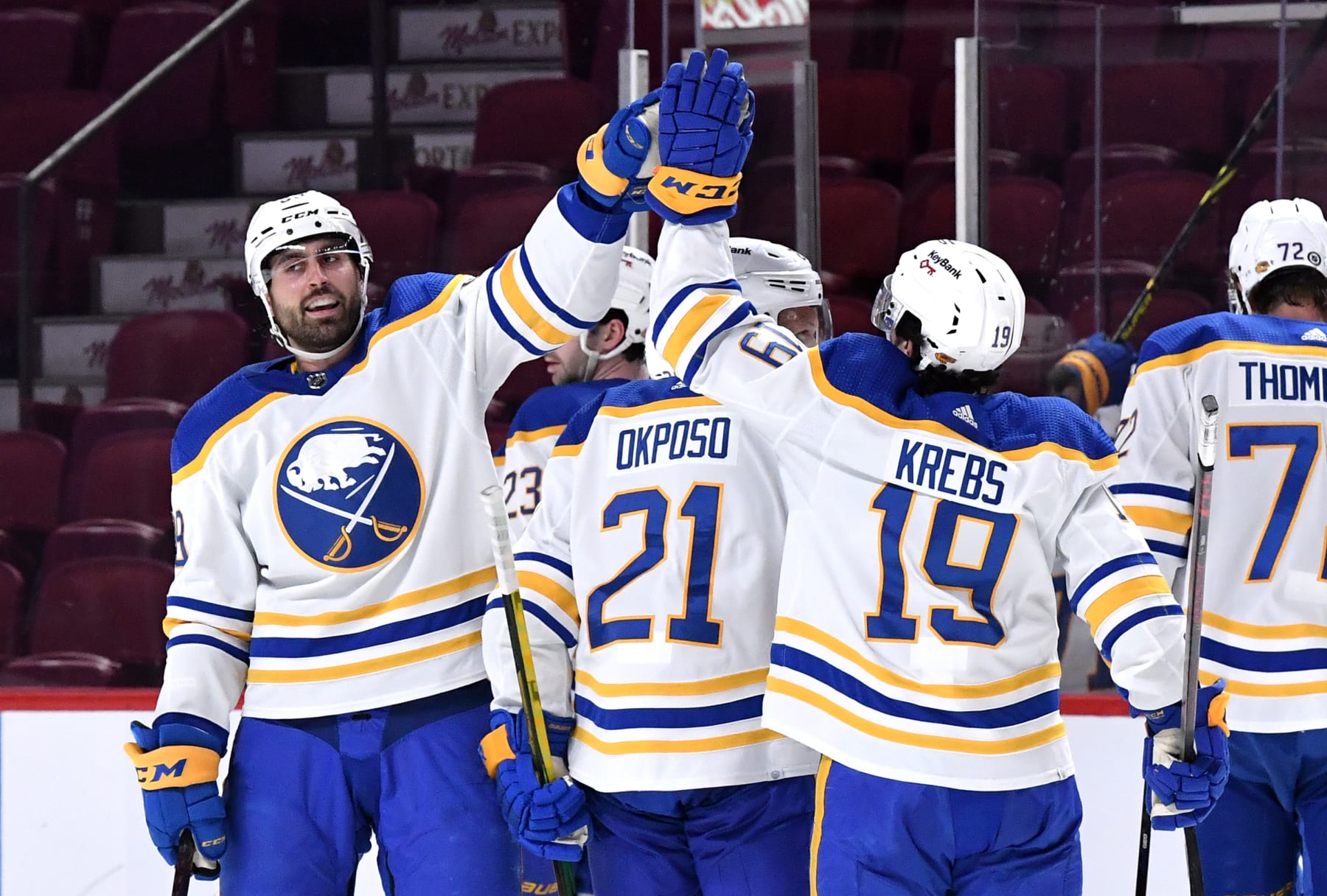
BUFFALO, N.Y. – The first and last question asked after any sports trade is “Who won the deal?”
Nov. 4 will be the one-year anniversary of when the Buffalo Sabres traded Jack Eichel and a conditional third-round pick in 2023 to the Vegas Golden Knights for Alex Tuch, Peyton Krebs, a 2022 first-round pick (Noah Östlund), and a 2023 second-round pick. Both teams have to feel good about the returns so far.
Eichel has put up 10 points (four goals, six assists) in 10 games this season. Meanwhile, the Sabres should be thrilled with the haul of young players and picks they received.
That the Sabres can claim success after giving up the best player in the trade shows how well they did. Being handed the reins of a team whose best player wants out isn't ideal, but first-time general manager Kevyn Adams saw it as an opportunity for a fresh start.
"The day that trade was made, 100 percent of my attention and focus was on who we got in the trade and what we need to do here to be better," Adams said. "The reality is, you have to have players that believe in what you're doing as an organization and truly want to be part of it. And those two players in particular [Tuch and Krebs]—and I'll say Noah Östlund because now that we've drafted him—they fit that. And that, to me, was a really important part of this."
For Buffalo, it meant cutting the final ties to an era that began with losing for the purpose to improve lottery chances and jump-start a return to glory with elite talent. Sam Reinhart and Rasmus Ristolainen were already gone. Moving Eichel to Sin City meant virtually every major tie to the pre-Adams regimes was cut.
The Sabres were no longer putting the hopes of returning to
the postseason for the first time since 2011—and the dreams of winning the
Stanley Cup—all on the back of one player. Eichel was a dynamo capable of
swinging a game by himself.
That approach didn’t work for the Sabres, though, because they lacked depth all over the roster. Instead, they decided to try assembling a more complete team, and Tuch gave them the spark they needed in the face of extreme change.
Tuch is a power forward the likes of which the Sabres haven’t had in ages. Nothing excites a Buffalo crowd more than a guy who can crunch opponents along the boards and fill the net.
"Something that he brings that's a little different is just as his size and his strength," teammate Tage Thompson said. "He's a beast out there, and combined with his speed, I think it catches a lot of people by surprise. They think they’ve got a lot more time with the puck and then he's right on you, which is good for us because we get the puck back quicker and then we get to go play offense."
In 50 games with the Sabres last season, Tuch had 12 goals and 38 points. He's off to a hot start this season, as he's tied with Thompson, Victor Olofsson and Rasmus Dahlin for the team lead in goals with six. He’s third on the team in points with nine, behind Thompson and Dahlin (12).
That’s the kind of impact the Sabres hoped he would provide with more ice time and opportunities than he had in Vegas.
"(Tuch) is clearly a player that other guys identify within the locker room as already a great, elite talent in the NHL, and the potential to be extremely impactful where we envision he can get to, that's clear and evident," Sabres head coach Don Granato said. "It's nice to have another player that comes in with that talent and that experience and still feels like a young guy. That's a great combination of everything."
In Vegas, Tuch was a young player in a sea of outstanding
skilled veterans. The move to Buffalo turned him into one of the Sabres' most
experienced veteran players at age 26.
"I was the youngest guy on the team (in Vegas), or at least when it came to games played, so I was pretty much a rookie for three years," Tuch said. "Now, it's crazy to be in the upper echelon in age on a team and you have all these younger guys below you."
Fans took to Tuch’s on-ice leadership immediately, and his teammates were right there with them. What’s more, neither Adams nor Granato asked him to adjust his affable, gregarious and fun-loving nature to act more like a leader.
It turns out that having him be himself is the exact kind of leader they needed. How he carries himself is infectious.
"He's a
great guy," Thompson said. "He's always in a good mood, so whether you're having a good or a bad
day coming to the rink, he's always buzzing around. So it's good for the
atmosphere in the room, and I think that translates onto the ice as well."
The addition of Krebs provided Buffalo with another offensively gifted player. Not since 2006 have the Sabres had so many young, skilled players, each of whom has distinct talents.
The 21-year-old Krebs' passing and vision is what allows him to stand out among the snipers, danglers and net crashers.
"That's a guy that no matter where I put him, on wing or at center, anybody and everybody's excited that he's on his line," Granato said. "They just believe that he can get them the puck, that he's going to make plays. And he's a fun guy to play with because he's creative."
Buffalo's lack of secondary scoring behind Eichel was glaring whenever he didn't produce. If he had an off night, the Sabres were virtually doomed to lose.
That’s
no longer a problem. They can spread the wealth among a few lines.
"One of the things that we spent a lot of time working on
was, how do we make sure any deal we make is looking at the long term, not
doing something reactionary, or with a short-term focus," Adams said. "That's
why it was so critical for us in that deal with Alex that he's in the prime of
his career and he had term on his contract. You get Peyton, who's in his first
year of an entry-level [contract] that we think is going to be a really good
player for us, and he has been, and he will continue to get better."
Minding the here and now as well as down the road is the key point of what it means to be an NHL general manager. The Sabres as previously constructed weren’t in position to immediately challenge for the Stanley Cup.
Right now, things are trending up. The Sabres are 6-3-0 with 12 points through nine games. It took them 11 games to reach 12 points last season.
They're taking baby steps, but with huge leaps in progress for their most important players.
"It's exciting to be part of something that's getting better every day," Krebs said. "It's been a lot of fun, and I'm excited to see where we go from here."
Phillies' Historic Home Run Outburst in Game 3 a Reminder the Long Ball is Still King
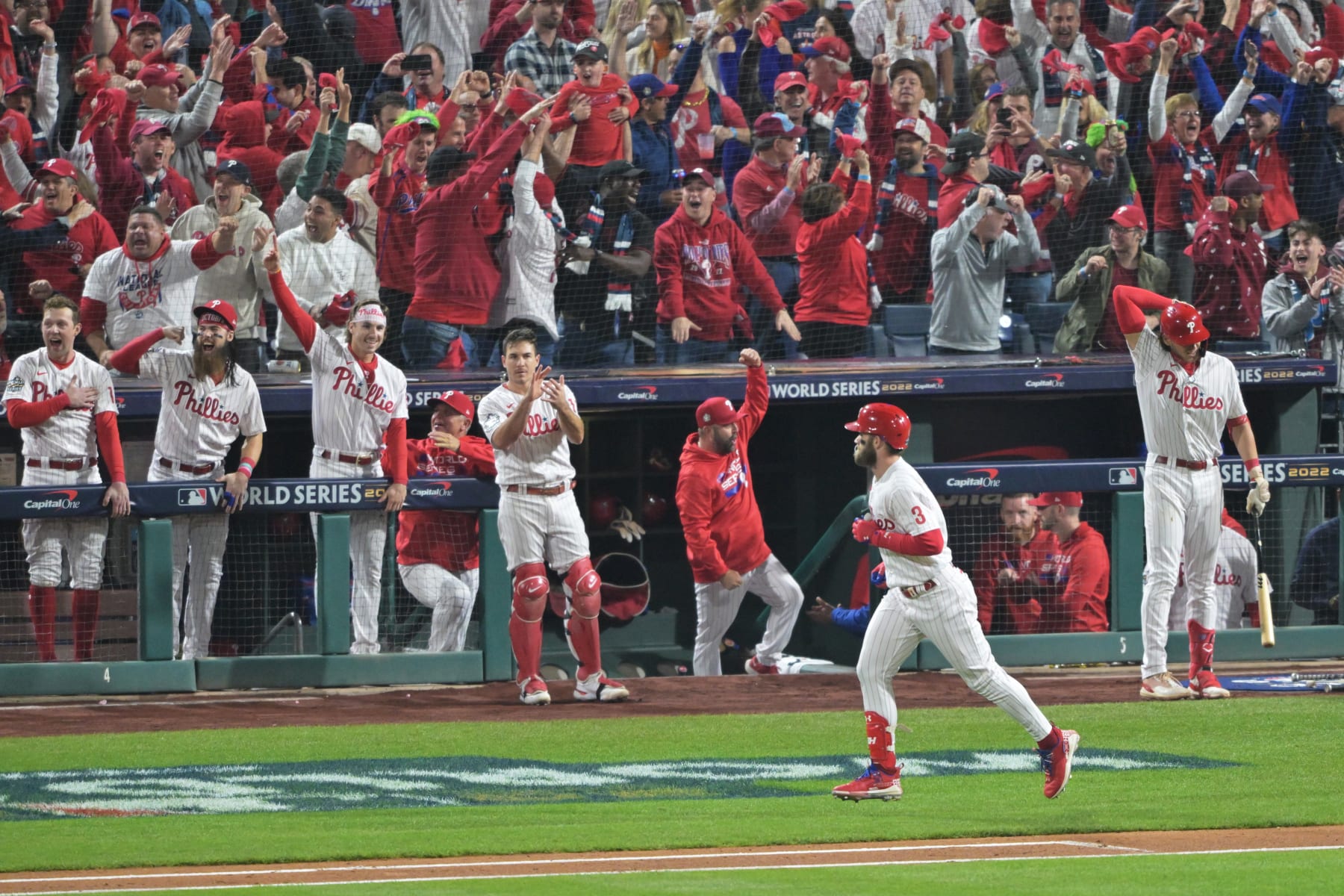
One day after rain rendered conditions unplayable at Citizens Bank Park, the only thing it was raining in Game 3 of the World Series was home runs.
As all five of them came courtesy of the home team, it was simultaneously with style and very much by the modern book that the Philadelphia Phillies took a 2-1 series lead over the Houston Astros in Tuesday's game.
Whereas the first two games of this year's Fall Classic were tense affairs at Minute Maid Park, the third saw the Phillies quickly bury the Astros en route to a 7-0 victory. The long balls came early and often, starting with Bryce Harper's two-run rocket off Lance McCullers Jr. in the first inning.
After that, it was Alec Bohm's and Brandon Marsh's turns via solo shots in the second inning. In the fifth, Kyle Schwarber and Rhys Hoskins got in on the fun with two-run and solo blasts, respectively.
Thus, the Phillies became the fourth team to hit five home runs in a World Series game. Bully for them and, well, not bully for McCullers. Since all five were charged to him, he became the first pitcher to surrender that many long balls in a playoff series, World or otherwise.
The Phillies Showed Why Home Runs Rule October

In the postseason, as in the regular season, the only surefire way for a team to win a game is to score more runs than the other team. It's baseball. Those are the rules.
In recent years, however, few other things have determined a team's success in October like the long ball.
Teams that won the home run battle within a postseason game also won the game itself 59.3 percent of the time between 2012 and 2021. The effect was only more pronounced in the 2021 playoffs, as teams that won the home run battle went 25-2.
It has been no great surprise, then, to see MLB.com's Sarah Langs' daily updates confirm that the long ball is still king in the 2022 playoffs:
It hasn't become impossible to carry out a more long-form offensive attack. The Phillies themselves know this to be true, as they were victorious in Game 1 of the Wild Card Series and Game 1 of the National League Division Series, even though they failed to go deep in both of them.
For the most part, though, it's because of the long ball that the Phillies are now just two wins shy of their first World Series championship since 2008. The five they hit on Tuesday gives them 22 for the playoffs, and it's hard to imagine a more illustrative example of why home runs have so thoroughly taken over the playoffs.
It's not just that the Phillies didn't get a hit with a runner in scoring position. It's also that, even though the final score might lead one to surmise otherwise, they got only three opportunities to do so. And the Astros? Same story.
Call it a microcosm of just how hard it is to get 'em on in Major League Baseball's modern playoff environment, much less get 'em over and get 'em in. Since 2012, on-base percentage has consistently taken a dive from the regular season to the postseason:
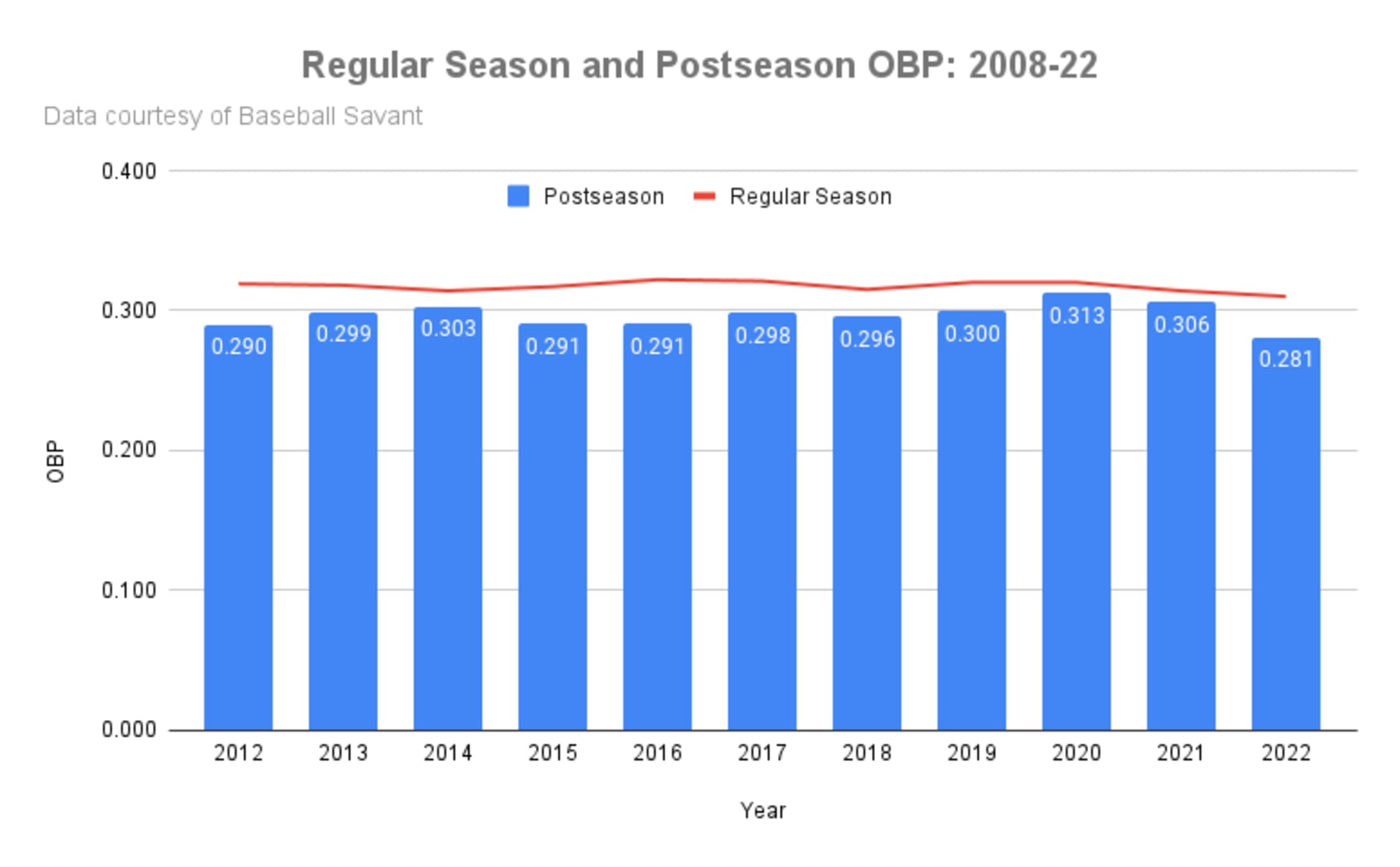
One can point to any number of explanations for what's causing this. For one, pitchers are just plain nasty. For two, every manager has a deep bullpen and is willing to use it. And for three, yes, swinging for the fences is just what modern hitters do.
As the Phillies showed in Game 3, however, actually hitting the ball over the fence can require more tact than simply trying to combine brute force with just the right launch angle.
"That's between us," said Bohm (h/t Rob Friedman) of the viral moment in which Harper said something into his ear just before he hit his home run. But with that and each successive bomb off McCullers, it only became clear that the Phillies had something on the 29-year-old hurler.
If he wasn't tipping his pitches—and McCullers maintains that he wasn't—he might simply have had too obvious of a game plan. He certainly stuck with the theme of his season in shying away from his fastball, especially against left-handed batters in the playoffs.
In a bygone era, the Phillies might have taken whatever information they had and used it to try to secure McCullers' demise through a thousand cuts. But in this era, trying for deeper, more damaging cuts was certainly the logical course of action.
The Astros Are in Trouble. Again.
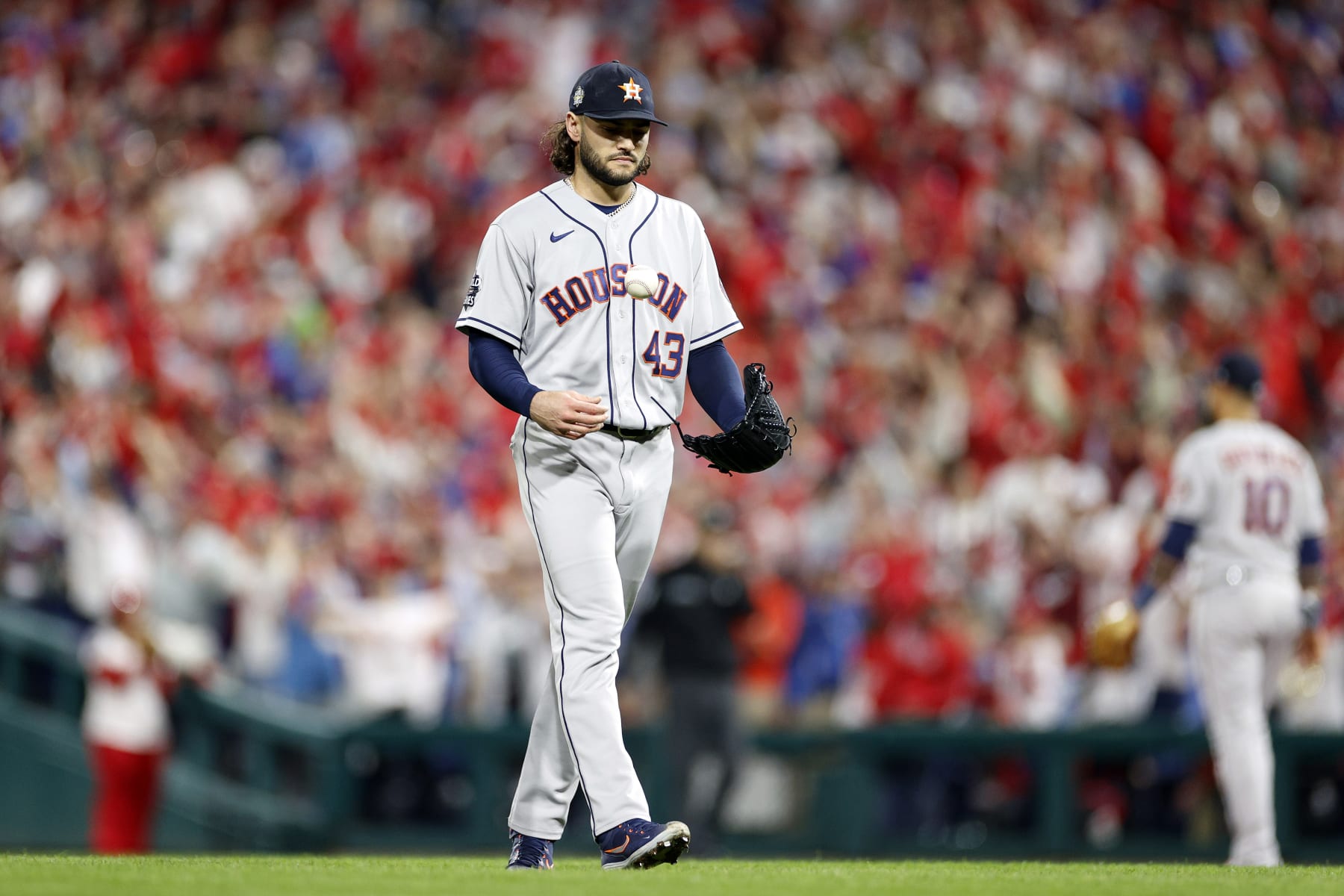
Save for the fact that Ryne Stanek and José Urquidy, the latter of whom was pitching for the first time since Oct. 3, combined for 3.2 scoreless innings in relief of McCullers, there just aren't any positives for the Astros to take away from Game 3.
So, the best thing they can do is turn the page.
If they must have some kind of extra motivation ahead of Game 4 on Wednesday, they can remember that the spot they're in now isn't all that dissimilar to the one they were in after the first three games of last year's American League Championship Series.
In that one, the Astros trailed 2-1 to the Boston Red Sox following blowout losses in Games 2 and 3. Those were the two games in which the Red Sox hit three grand slams, with the last being Schwarber's amid a six-run second inning that paced a 12-3 blowout at Fenway Park.
The Astros didn't just climb out of this hole. They rocketed out of it, outscoring the Red Sox 23-3 to win the next three games and punch their ticket to the World Series.
Yet for the Astros to enjoy a similar uprising against the Phillies, they're going to need to get their big bats going.
None of their guys can be fairly called "hot" right now, but Jose Altuve and Yordan Alvarez least of all. The former's latest 0-fer has him at 7-for-45 for the postseason, while the latter is now 4-for-32 since homering in each of Houston's first two playoff contests.
If anything, Houston's pitching outlook for the remainder of the series only heightens the pressure on the offense to break out.
With Cristian Javier set for Game 4 and Justin Verlander to follow in Game 5 on Thursday, Framber Valdez would be the presumptive starter for Houston if the series goes to a Game 6 on Saturday. Should a Game 7 materialize on Sunday, manager Dusty Baker will have a hard decision to make.
He'd have the option of starting McCullers on regular rest, but that seems like a dangerous proposition after what happened on Tuesday. He could otherwise bring Javier back on three days' rest, though that would be uncharted territory for the 25-year-old.
In any case, the Phillies are in better shape with Ranger Suárez lined up for a potential Game 7. Since his rough playoff debut in Game 1 of the NLDS, the sinker-balling lefty has allowed just one earned run on six hits and one walk over 11.1 innings in two starts and two relief appearances.
What's Next for the Astros and Phillies?
The World Series will continue with Game 4 at Citizens Bank Park on Wednesday. First pitch is scheduled for 8:03 p.m. ET.
On the mound for the Astros will be Javier, whose lone playoff start in Game 3 of the American League Championship Series yielded 5.1 scoreless innings. Aaron Nola will take the ball for the Phillies. He's surrendered 11 runs in his last two starts, but he'll at least be on regular rest.
Game 5 will be on Thursday. If necessary, Games 6 and 7 will be in Houston on Saturday and Sunday.
Stats courtesy of Baseball Reference, FanGraphs and Baseball Savant.
Tennessee Deserves No. 1 Spot in CFP Rankings, but Georgia Clash Will Define Season
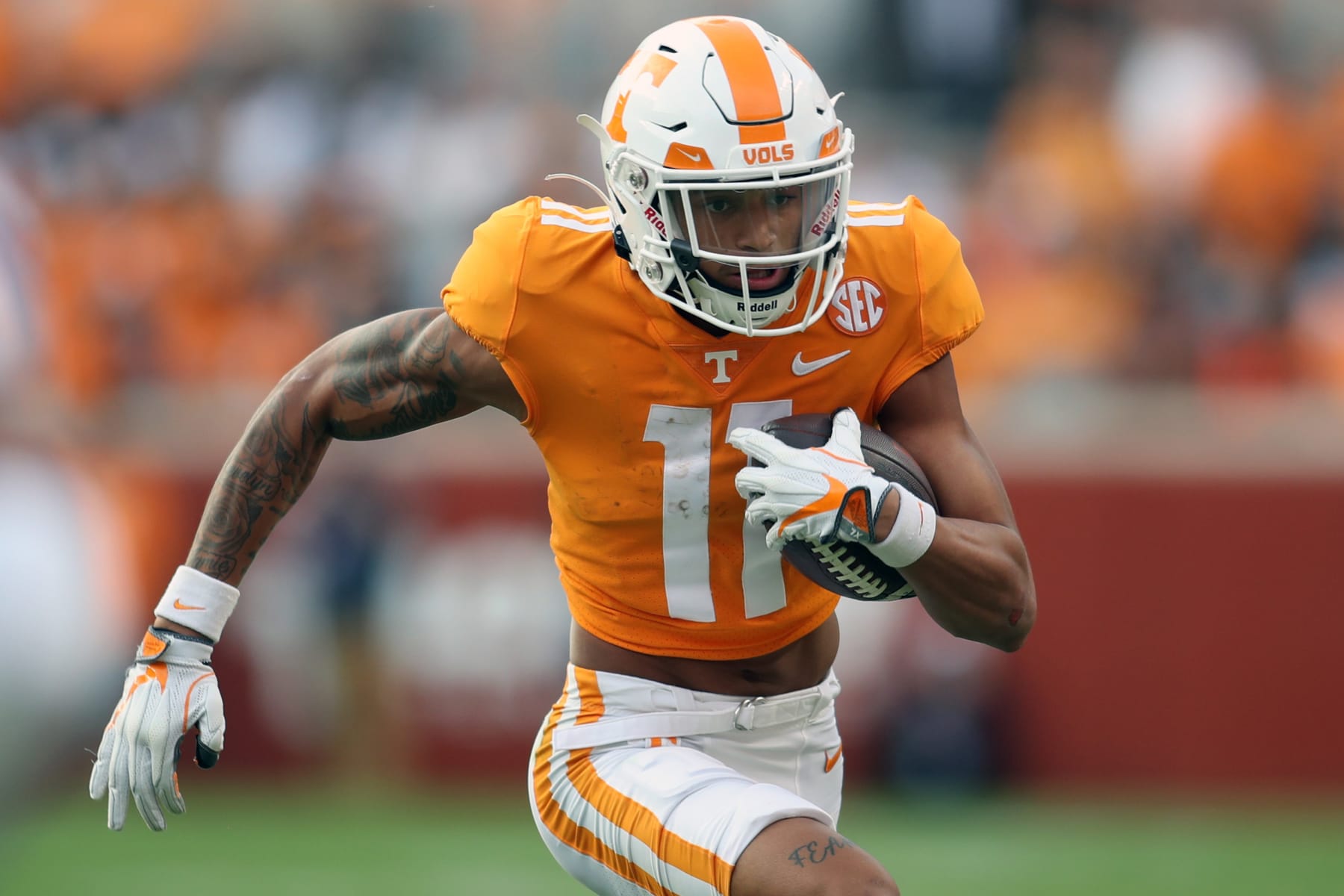
The Tennessee Volunteers have fully earned the No. 1 spot in the initial 2022 College Football Playoff rankings. That much should be extolled within the program.
There is also an expiration date on that celebration.
And it's probably, oh, Nov. 2.
In reality, the only immediate thing that matters for the Volunteers is whether they defeat the third-ranked Georgia Bulldogs on Saturday in Athens. Because, my friends, the poll is certain to change next Tuesday, and that No. 1 status will be much less significant if UT loses.
Tennessee is still the underdog, the program that hasn't won a conference title in 24 years. The burden of proof remains on the Vols, and no reasonable person would argue that outlook.
Simultaneously, both the metrics and eye test agree that none of the other five undefeated teams can present a stronger case than Tennessee to stand atop the rankings right now.
Tennessee is 8-0 with marquee victories over sixth-ranked Alabama and No. 10 LSU. Georgia has a lone ranked win against No. 8 Oregon, as do both Ohio State and Michigan opposite No. 15 Penn State.
Clemson boasts three Top 25 wins (No. 20 Syracuse, No. 21 Wake Forest and No. 22 NC State), and TCU has a pair (No. 13 Kansas State and No. 18 Oklahoma State). However, neither one has dominated games like UT did at LSU—or even against 5-3 Kentucky.
Ranked opponents aren't the only impactful games, of course; Tennessee's total strength of schedule (19th) is well above OSU (52nd), TCU (63rd), Clemson (72nd), UGA (75th) and U-M (79th).
Considering that highest competition level, what the Vols have accomplished is unmatched. The overwhelming offense—led by Heisman Trophy contender Hendon Hooker—is the nation's highest-scoring unit. Alabama kept it close, but Tennessee hung 52 points on the Tide anyway.
Now, I hear you, Dawgs fans. You might be trying to throw the proverbial ace in the hole.
Georgia won last season's national title and remains undefeated. Shouldn't that count for something?
Well, no! Last year is last year. Tennessee has played a tougher schedule so far and performed tremendously against that difficult slate. The rankings are a reflection of what's already occurred, not what happened in a previous season or might soon.
The takeaway is simple: Go prove it again.
That's what it's all about, right? Georgia, which steamrolled what has become a high-quality Oregon team, is favored to beat Tennessee. Do that, and—voila!—the Dawgs immediately become the team indisputably deserving to sit atop the rankings throne.
As always, these rankings will work themselves out. The on-field impact of this initial poll is very minimal.
Sure, Georgia may have a little extra motivation to beat Tennessee. You know UGA coach Kirby Smart and his staff are ready to sprinkle in the message that the reigning champs are being disrespected.
But it's not like Georgia wouldn't have been adequately motivated if the Vols had been ranked second or third instead. Let's be serious here.
Off the field, it would be unfair to suggest the ranking means nothing for Tennessee. This is a quality selling point for the recruiting trail, where prospects are destined to hear how Tennessee has proved it can reach No. 1. The future value of that for the program—considering its recent instability—should not be dismissed.
Maximizing that pitch, however, involves an actual win over UGA. Tennessee hasn't done that since 2016.
Georgia, meanwhile, is a not-so-simple victory away from a straightforward counterargument: Yeah, the Vols had a breakout year, but they couldn't beat us. We're still the champs.
This is a nice achievement for the Vols, but the debate will be settled Saturday. Either the Vols take another step toward the College Football Playoff, or Georgia's reign in the SEC East continues.
And the rankings will take care of themselves.
Shinsuke Nakamura vs. Great Muta Will Be Historic Moment in Wrestling, but a One-Off
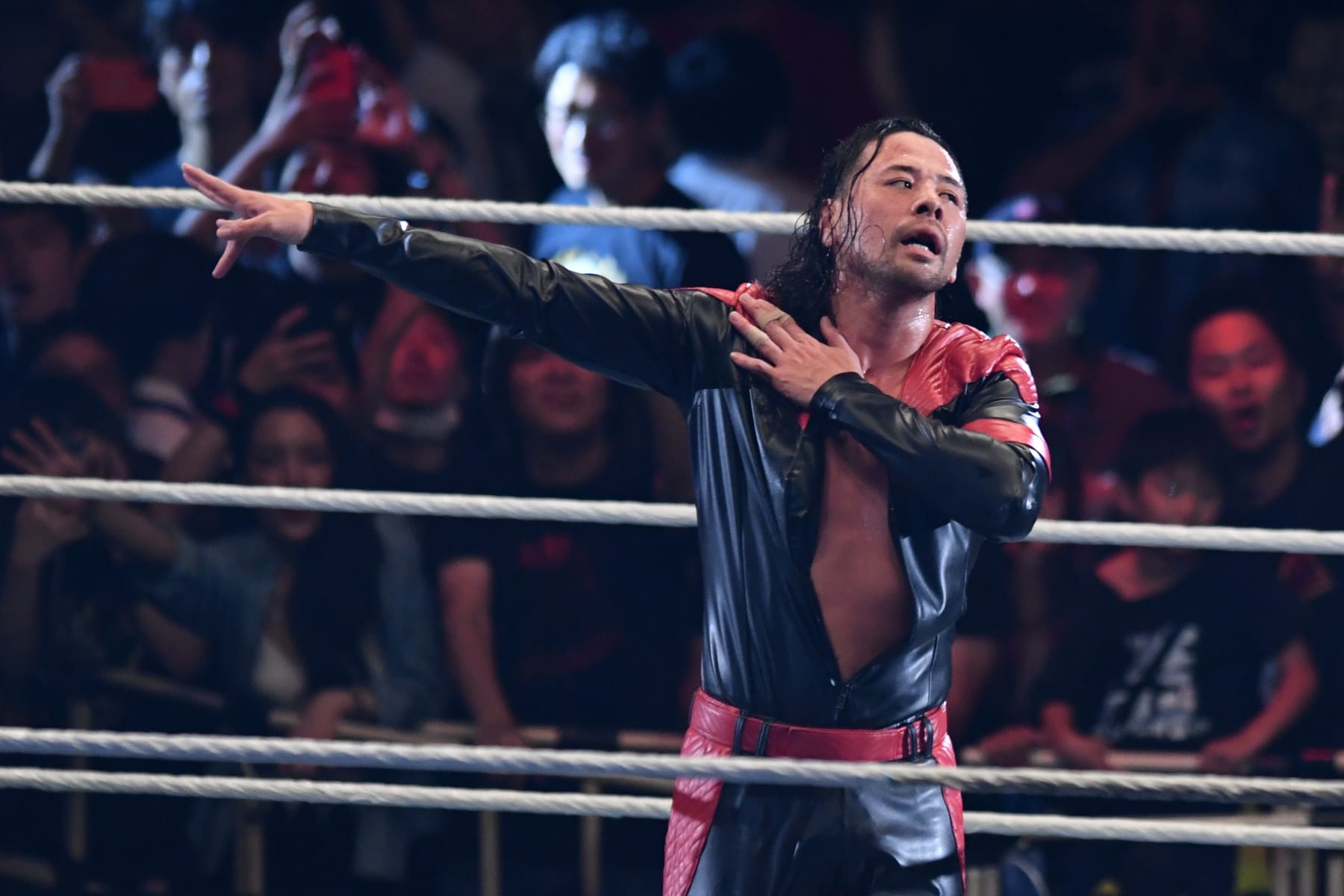
On Sunday, Pro Wrestling Noah announced Shinsuke Nakamura will face The Great Muta on New Year’s Day. The revelation stunned the wrestling world, leading many to wonder how the stars aligned for a final matchup between the two.
The news will, undoubtedly, spark hope for more crossovers or partnerships, but it’s best to just enjoy another surreal moment in an unbelievable year.
Muta plans to retire next spring. The 38-year veteran has two more matches left on his farewell tour with Noah following his appearance over the weekend in a six-man tag match at Ariake Arena in Tokyo.
On Jan. 1, he will take one Nakamura in a one-on-one bout. Then, he will compete for one last time as The Great Muta persona when he teams up with Sting on Jan. 22 in Yokohama.
In addition, he will join Kazuchika Okada and Toru Yano in an encounter against The United Empire as his final appearance for New Japan Pro-Wrestling on Nov. 20 as a part of NJPW X Stardom Historic X-Over.
It’s unclear if the innovative Japanese legend has any more dates left to announce for next year. Nevertheless, this is a star-studded sendoff for a man who deserves to get his flowers while he can still smell them.
The Clash of Two of NJPW’s Defining Stars
To say Muta has been an incredibly influential performer almost seems like an understatement. He popularized the use of the green mist, which has become a staple in pro wrestling.
It inspired notable names like Tajiri, Kishin Liger and Asuka. He also pioneered many moves, such as the Shining Wizard, his famous moonsault, Dragon Screw leg whip and the Muta Lock.
While many mainstream U.S. fans may remember his stint with WCW, the 59-year-old made a name for himself with NJPW as Keiji Muto. He was instrumental in the company’s success in the early 1990s as one of the original Three Musketeers with Masahiro Chono and Shinya Hashimoto. They became the backbone of the promotion following Antonio Inoki’s generation.
In March 2002, Nakamura joined New Japan and developed into one of its fastest-rising stars. The Super Junior went on to become the youngest IWGP heavyweight champion in 2003. He, Hiroshi Tanahashi and Katsuyori Shibata became the new Three Musketeers as the company struggled to find a new identity.
Still, his initial reign was a bit forgettable because he sustained various injuries, which forced him to vacate the title after 58 days. When he returned, he unsuccessfully challenged Bob Sapp and famously wrestled Brock Lesnar at the Tokyo Dome before he went on an excursion in 2006.
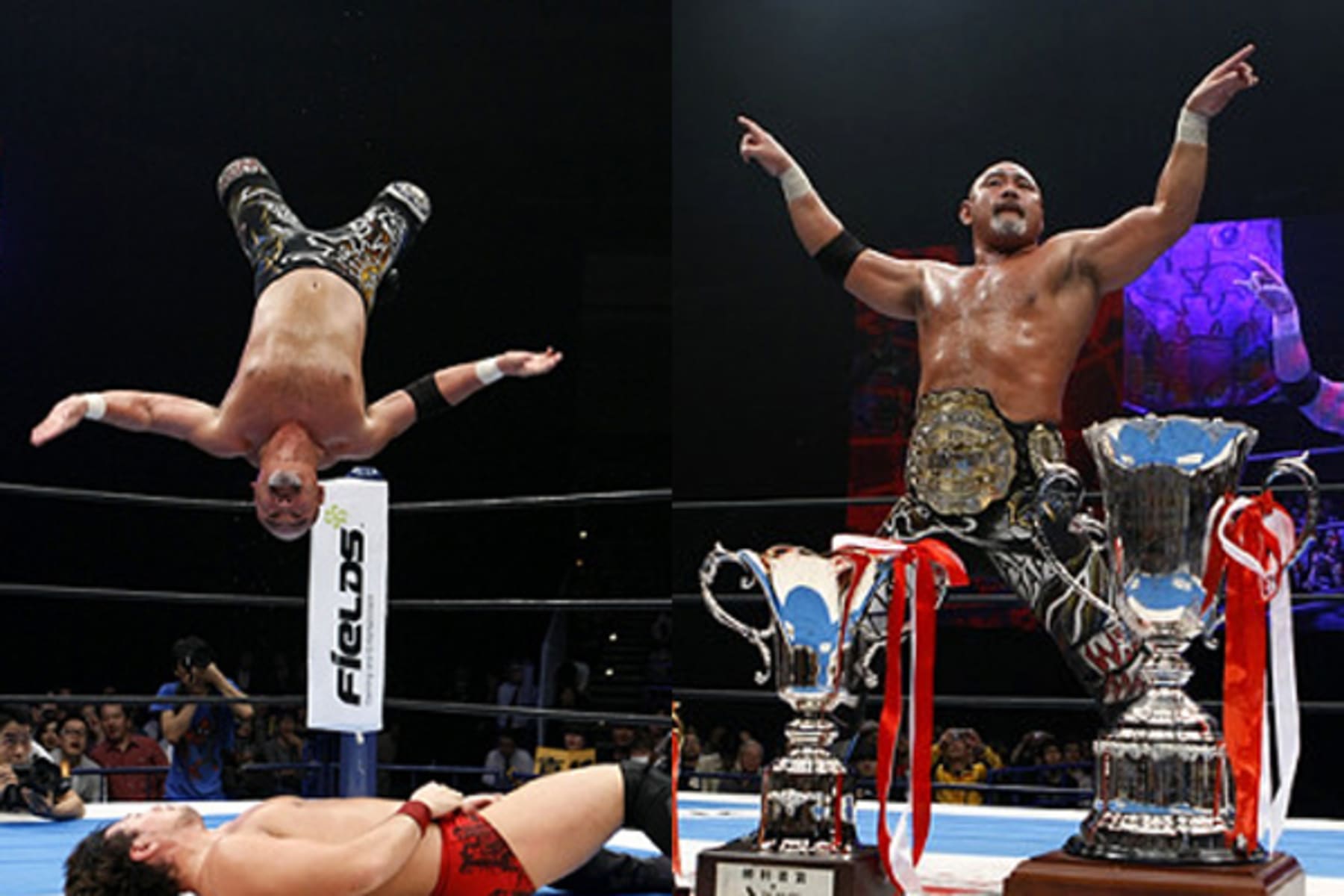
After Inoki-ism failed to reinvent NJPW, Nakamura reemerged as one of its top stars and started his iconic feud with Tanahashi.
The King of Strong Style defeated his rival at Wrestle Kingdom II to win the IWGP Heavyweight Championship. His second reign put him on the map, as he became the first Japanese wrestler to beat Kurt Angle in a title unification in 2008.
This victory restored the lineage of NJPW’s top prize and helped him earn the respect of his peers. In March, Muto returned to the company as a representative from All Japan Pro Wrestling and defeated Nakamura for the title.
Together, the two generations of Musketeers have helped to revitalize the promotion and kick off its growth into the popular entity we know today.
The two Japanese legends haven’t stood toe-to-toe in the ring in 14 years. Coincidentally, sending the former intercontinental champion to Japan on behalf of WWE brings their last encounter full circle. It’s an excellent way to pay tribute to Muta and acknowledge his contributions to NJPW.
How Is This Miraculous Match Possible and What Does It Mean?
The King of Strong Style described the match as a "miracle" in his interview with Tokyo Sports (h/t PWMania.com). He pushed for talks with the new regime after Vince McMahon retired, and the two parties came to an agreement on Oct. 26 thanks in part to his persistence.
"Of course, I wanted to do it," Nakamura said. "I opened a door that no one had been able to pry open. Hahaha...it’s a real ‘Forbidden Door.’"
Some fans may see his joke about the “real” Forbidden Door as a jab at All Elite Wrestling, which recently entered a partnership with NJPW. However, many of us always expected those two companies to work together because they share a fanbase and The Elite originated in New Japan. Even more, Tony Khan was always open to working with other promotions.
Getting WWE to work with Noah was a much tougher task because it historically doesn’t enter into such talent exchanges. The move will likely create goodwill with the Japanese company, but fans shouldn’t expect this to turn into a full-blown partnership.
This seems more like a one-off appearance that worked out perfectly for Muta and Nakamura. Of course, never say never in pro wrestling. More preposterous things have happened in 2022 alone, but Triple H still seems to have his eye on global expansion for WWE rather than forging partnerships with other companies.
Still, it’s nice to know that his regime is more willing to help historic moments like this. It’s a good sign for the overall outlook on the future of the industry.
